| Vocademy |
Speaker Enclosures
There are many types of speaker enclosures and working with them is a specialty that will not be dealt with here in detail. However, you do need a basic understanding of the different types of enclosures. The following are the most common types of enclosures you will encounter.
Sealed enclosure
This enclosure is completely sealed. Since air cannot escape from the enclosure, pressure causes a damping effect.
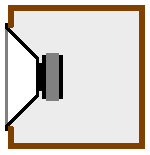 |
| A sealed enclosure |
This lowers the response of the speaker and widens the frequency response. There is a tradeoff between efficiency and frequency response with this type of enclosure. Acoustic suspension speakers require this type of enclosure. The enclosure must be designed with the correct internal volume for the speaker.
Bass-reflex
A bass-reflex enclosure has an open-ended tube extending into it.
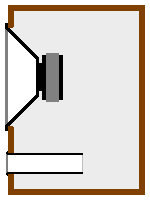 |
| A bass reflex enclosure |
Without the tube—with a simple hole in the enclosure—the sound coming off the back of the speaker element would be 180 degrees out-of-phase with the sound coming off the front of the speaker. Therefore, the sound coming out of the hole would tend to cancel the sound coming off the front of the speaker. The length and diameter of the tube, along with the volume of the enclosure is designed to resonate at a frequency substantially lower than the natural resonant frequency of the speaker element. This creates a phase delay that causes the sound coming out of the hole to be in-phase with the sound coming off the front of the speaker. This combines both sets of sound waves into a single force that increases the overall efficiency of the speaker at low frequencies.
Passive radiator
A passive radiator enclosure is similar to the sealed enclosure. It has a second speaker that is not a complete speaker but just the diaphragm with no voice coil and no magnet.
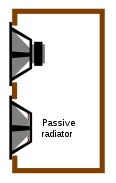 |
| A passive radiator enclosure |
This diaphragm vibrates with the speaker and affects the resonance of the enclosed box. They tend to not peak at the resonant frequency as bass reflex enclosures do. They are more complex to design and more expensive to build.
Multielement speakers
Most speaker systems use more than one speaker element. Typically, there are two elements, one that responds well to low frequencies and one that responds well to high frequencies. The low-frequency element is called the woofer and the high-frequency element is called the tweeter. A three-way speaker also has an element that responds the middle frequencies called the midrange element.
Crossover networks
A woofer element is not efficient at converting high frequencies to sound waves. Such low-frequency energy is converted to heat instead[1]. Likewise, a tweeter only produces heat with low frequencies. A multi-element speaker uses a filter called a crossover to direct the high frequencies to the tweeter and the low frequencies to the woofer.
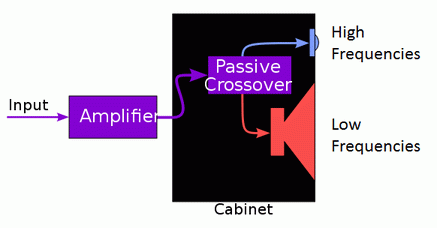 |
| A multielement speaker with crossover |
The tweeter is the speaker element that most needs to be compensated. Therefore, the simplest crossover is just a large capacitor in series with the tweeter. Special crossover capacitors are made for this purpose[2].
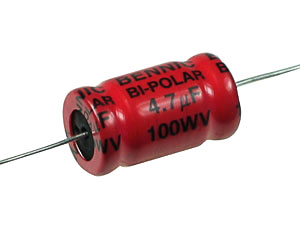 |
| An non-polarized electrolytic crossover capacitor |
A slightly more-sophisticated crossover consists of an inductor in series with the woofer as well as a capacitor in series with the tweeter. Crossovers for more expensive speakers will have RC or LC filters to direct the correct frequencies to the correct speaker elements.
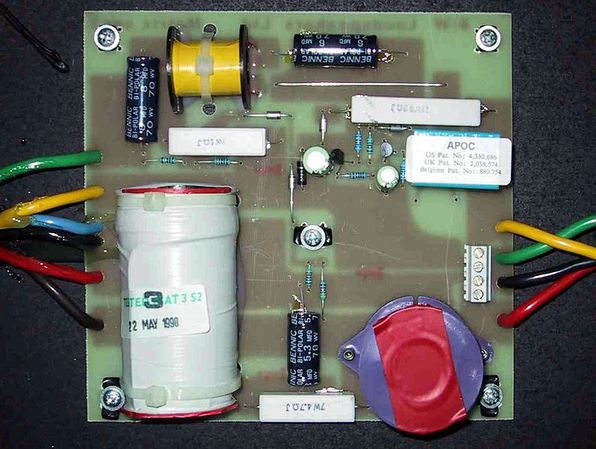 |
| A crossover network using high-pass and low-pass filters |
Subwoofers
The human auditory system is good at telling where higher frequency sounds come from but poor at telling where low-frequency sounds come from. Therefore, for good stereo sound (see Speaker Arrangements) you don't need a woofer with every speaker. Many stereo systems will have separate tweeters. The small tweeters can be placed conveniently where needed for sound placement. For bass sounds, a woofer (usually called a subwoofer) is placed out of sight.
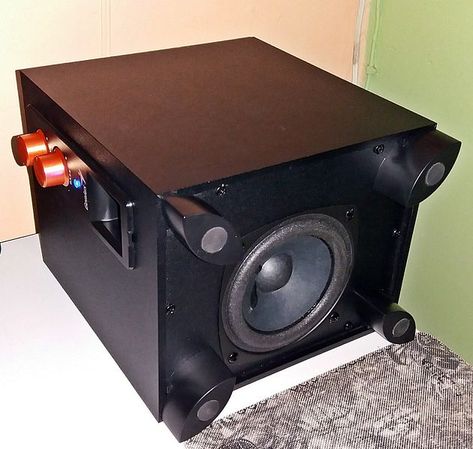 |
| A floor mount subwoofer on its side |
The illusion of sound placement is maintained. The ear associates the bass sounds with the corresponding treble sounds.
Many systems will incorporate small woofers with each speaker and a subwoofer with extra-low frequency response.
Loudspeaker Basics and Enclosures
| Vocademy |
